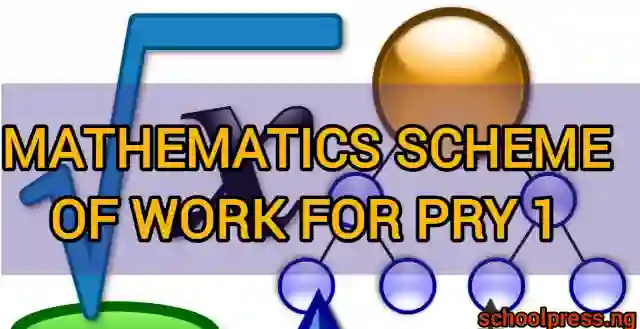The Mathematics scheme of work for Primary 1 pupils is analyzed. It should be said that this plan has multiple advantages. For example, this scheme provides a framework for teaching mathematics.
Moreover, the curriculum may be divided into the relevant units, topics, and objectives for each term . This way, coherent and fascinating lessons are created.
The spiral approach is majorly implemented in this scheme to ensure a comfortable progression from one level to the other. This plan also focuses on the fact that learners are uniquely different in their learning and, therefore, facilitates differentiation by the teacher. d
Additionally, teachers have an opportunity to personalize activities and resources in terms of their pupils’ peculiar needs and interests and provide appropriate support and challenge.
The scheme of work is based on formative and summative assessment strategies that help teachers and the teacher evaluate and track pupils’ learning and progress, provide feedback, identify areas of strength and weakness, and plan intervention or development.
Table of Contents
Objectives of the Mathematics Scheme of Work for Primary 1
First Term Objectives
Week 1: Sort, classify and identify number of objects in a group or collection.
Week 2: Write and count correctly number 1 – 5, Arrange numbers 1 – 5 in order of magnitudes. (Quantities).
Week 3: recognize that symbol 0 stands for nothingness and write and read the number o.
Week 4: Sort and classify numbers of objects in a group or collection, identify numbers of object in a group of collection, Count and read correctly from 1 – 9.
Week 5 : recognize the number 10, recognize 10 as a group.
Week 6: Identify tens and units i.e. the bundles and the ones, Join units of different numbers to make the numbers 11, 12, 13 …. 19.
Week 8: Identify and read correctly the numbers of 1 – 99, write correctly the numbers 1 – 99
Week 9: identify V and % using concrete objects and shapes
Week 10: divide an object e.g. an orange into 4 equal parts and identify one quarter of an object.
Second Term Objectives
Week 1: add two whole numbers from 1 to 3 with sum less than 5, add two or three whole numbers from 1 – 8 with sum not up to 10.
Week 2: Add two or three numbers from 0 to 9 with sum not greater than 18.
Week 3: Add 2-digit whole numbers with sum not greater than 40 without exchanging or remaining.
Week 4: Subtraction from whole numbers not greater than 9
Week 5 : Subtraction from whole numbers not greater than 18, Crosscheck accuracy in subtraction
Week 6: Find missing numbers in a statement, Crosscheck the correctness of addition in everyday life
Week 8: Find the missing numbers in a statement, Crosscheck the correctness of subtraction in everyday’s life.
Week 9: Find missing numbers in an open sentence, Solve simple related open sentences involving addition and subtraction.
Week 10: Identify and recognize different values of the Nigerian currency (coins).
Third Term Objectives
Week 1: develop the idea of length, compare length of two or three objects, order similar objects according to lengths.
Week 2: Measure length and distance in their natural units, apply the length and ordering of length in our environment.
Week 3: Demonstrate knowledge of the idea of time, Mention when certain things are done: (Home and school)
Week 4: Compare the weights of some common objects in the school using the terms light and heavy.
Week 5 : Identify a square, a rectangle and a circle.
Week 6: Distinguish between squares and rectangles, Mention square, rectangular and circular shapes in homes.
Week 8: sort out cubes, cuboids, cylinders and spheres, identify and name cuboids, cylinders and spheres, distinguish between cuboid and cubes and mention solid shapes in homes and environment.
Week 9: collect data on their ages at home and schools, Collect data on their heights.
Read More: 2024 JAMB UTME Form: Know The Important Information For The Exam Registration
Learning Outcomes of the Mathematics Scheme of Work for Primary 1
First-Term Learning Outcomes
Week 1: sort given number of objects from a collection and arrange given number of objects from a collection together.
Week 2: Write number 1 – 5 in numerals and in words in their exercise books. Order given numbers in order of their magnitude form.
Week 3: Remove objects from the bags till nothing is left in the bags, Write and pronounce the number 0.
Week 4: Arrange given number of objects from a collection together, identify number 6 – 9 and read number 1 – 9 on the board and from the flash cards.
Week 5 : Identify number 10 and Sort collection of objects into10.
Week 6: Count bundles of ten bottle tops and read numbers 11- 19.
Week 8: Identify and read correctly given numbers between 1 – 99 and write correctly the numbers 1 – 99
Week 9: cut given oranges into given parts, label given drawing of halved and quarter of objects and shapes and Fold rectangles or circular shapes into halves and quarters.
Week 10: Colour or shade (%) of the given shapes.
Second Term Learning Outcomes
Week 1: Add given whole numbers and add two or more whole numbers less than 10.
Week 2: Add two or three given whole numbers less than 18.
Week 3: Add 2-digit numbers and record their results and mention three everyday activities where accuracy is necessary.
Week 4: Subtract given whole number not greater than 9.
Week 5 : Subtract given whole number not greater than 9, Mention two examples of everyday activities where accuracy in subtraction is needed.
Week 6: Find the missing numbers in a given statement and Mention four areas where the accuracy of subtraction is required in daily life.
Week 8: Find the missing numbers in a given statement and Mention four areas where the accuracy of subtraction is required in daily life.
Week 9: Solve given problems on open sentences, Find simple numbers in open sentences)
Week 10: Solve the problems associated with money
Third Term Learning Outcome
Week 1: give examples of lengths and measures given lengths with steps, hand spans, strides and feet and give answers.
Week 2: Compare the length of given objects using “longer than and “shorter than”, Order bundles of sticks of various lengths using length, State the use of length in the society, Measure and order given objects by length.
Week 3: State the time of sleeping, state the time of coming to school etc.
Week 4: Compare the weight of different objects saying which one is ‘heavier’ or ‘lighter’.
Week 5 : Match a given flat face with the name: square, rectangle and circle, state the various features of a square, rectangle and circle.
Week 6: Name three square, rectangular and circular shapes in their homes.
Week 8: Sort out different solids (shapes) according to their shapes, identify and name different solids’ shapes, Distinguish between given cuboids and cubes, Given examples of solid shapes in their homes and environment
Week 9: Group themselves according to their: ages; height and mention their ages and heights.
Read More On Primary 1 Scheme of Work
Basic Science Scheme of Work For Primary 1
Islamic Religious Studies Scheme of Work for Primary 1
Cultural and Creative Arts Scheme of Work for Primary 1
Basic Technology Scheme of Work for Primary 1
Physical Health Education Scheme of Work For Primary 1
Information Technology Scheme of Work For Primary 1
History Scheme Of Work for Primary 1
Christian Religious Studies Scheme of Work for Primary 1
Civic Education Scheme of Work for Primary 1
Social Studies Scheme of Work for Primary 1
First Term Mathematics Scheme of Work for Primary 1
| WEEK | TOPIC | CONTENT |
| 1 | Whole numbers 1 – 5 | Sorting and classifying objects leading to idea of 1 – 5. 2. Identification of a number of objects. 1 – 5. |
| 2. | Whole numbers 1 – 5. | Reading of numbers 1 – 5 and writing of numbers 1 – 5. 2. Ordering of number 1 – 5. |
| 3. | Whole numbers 0 (Zero). | Identify number 0. (zero). 2. Tracing and writing number. |
| 4. | Whole number 6 – 9. | Sorting and classifying objects leading to idea of 6 – 9. 2. identification of numbers 6 – 9. 3. Counting and reading numbers 1 – 9. |
| 5. | Whole number 10. | 1. Recognition of 10 as a number. 2. making set of 10 members with various objects. |
| 6. | Whole numbers 1 – 19. | Tens and ones or tens and units. 2. Counting and reading tens and units of different numbers with their correct names. |
| 7. | Mid Term Test | |
| 8. | Whole numbers 1 – 99. | 1. identification and reading of numbers 1 – 99. 2. writing of numbers 1 – 99. |
| 9. | Fraction | Identification of Vz and % using concrete objects and shapes. |
| 10. | Fraction | Identification of one- quarter of whole. |
| 11. | Revision | |
| 12 & 13 | Examination |
Second Term Mathematics Scheme of Work for Primary 1
| WEEK | TOPIC | CONTENT |
| 1 | Addition | Addition of whole numbers with sum less than 5. addition of whole numbers less than 10. |
| 2. | Addition | Addition of whole numbers with sum less than 18. |
| 3. | Addition | Addition of items of 2- digits whole numbers with sum not greater than 40. |
| 4. | Subtraction | Subtraction from whole not greater than 9. |
| 5. | Subtraction | Subtract from whole numbers not greater than 18. |
| 6. | Addition | Find the missing number in a statement 6 ’ + □ = 8 5 + □ = 9 7 + □ = 9 3 + □ = 8 |
| 7. | Mid Term Test | |
| 8. | Subtraction | Find the missing numbers e.g. – □ = 4- □ = 5 5 – □ = 3 |
| 9. | Open Sentences | Find the missing numbers in addition. 2. Find missing numbers in subtraction. |
| 10. | Money | Nigerian coins 25 k, 10 k, 5k, 1k, and ^k. Sum of two or three coins.Shopping with a 10k piece and receiving change.Tracing of coins. |
| 11. | Revision | |
| 12 & 13 | Examination |
Third Term Mathematics Scheme of Work for Primary 1
| WEEK | TOPIC | CONTENT | |
| 1 | Length | idea of length. comparison of length of two or more objects to develop the idea of ‘longer than’ and ‘shorter than’. 3. ordering of lengths of objects. | |
| 2. | Length | Measuring of length and distance using natural units such as hand length, stride etc. 2. Measuring and ordering of length. | |
| 3. | Time | Introduce the idea of time.Time when certain things are done e.g. -morning, -afternoon, evening and night. | |
| 4. | Weight | Estimating weights by lifting different objects. Ordering of weights.Stating the importance of weight and areas where weight can be used. | |
| 5 & 6 | Squares, rectangles and circles. | Squares, rectangle and circles. | |
| 7. | Revision and Continuous Assessment | ||
| 8. | Two-dimensional shapes. | Cubes, Cuboids, Cylinders and Spheres. | |
| 9. | Data collection. | Three-dimensional shapes | |
| 10. | Quantitative Reasoning. | ||
| 11. | Revision | ||
| 12. | Examination | ||
Teacher’s and Pupils Activities
First Term Teacher’s and Pupil’s Activities
Week 1: The teacher should Mix the collection and asks Learners to sort them according to types, guides learners to form groups, one for stones, two for bottle tops, three for beans, four for button and five for balls.
The Pupils should Sort them according to the types, Sort and classify the mixed collection by forming groups for objects e.g. pick a stone, pick two bottle tops etc.
Week 2: The teacher should ask Learners to reads number 1 – 5 and write number 1 – 5 on the board. And guide learners to write the numbers in order in their books and
The Pupils should write numbers 1 -5 in their exercise book. Use counters to arrange objects in magnitude or in ordering form.
Week 3: The teacher should guide learners to put one stone in one bag, two stones in the sack bag and three stones in the third bag and none in the fourth bag, write the number 0 and remove the stones in each bag until there is no stone left.
The Pupils shouldput the stone into the bags as directed by the teacher.
Week 4: The teacher should guide learners to mixed the collection and sort out the ball’s pebbles, bottle tops and buttons together and guide the learners to classify each group of similar objects as follows, Count out five balls, Add one ball to two balls.
The Pupils should sort and classify the mixed collection e.g. collection of balls, collection of pebbles etc., identify the numbers 6 – 9 through the activities and the use of flash card.
Week 5: The teacher with the pupils should recognize the number 10, sort collection of objects into 8, 9, and 10.
Week 6: The teacher should Lead Learners to make a bundle of ten sticks, lead learners to add ones (using counters) to make sets of tens and ones – 11 up to ten and nine – 19.
The Pupils should Count in tens to make a bundle of 10 sticks. Add ones to the bundle to make sets of tens and one = 11, up to ten and nine = 19.
Week 8: The teacher should Uses the teaching resources to assist learners identify and read the number 1 – 99.
The Pupils should read and write numbers 1 – 99.
Week 9: The teacher should present each object as one whole, cut and divide an object into two equal parts and explain that each part is V.
The Pupils should Practice writing such objects into 1 and V, Match drawings of V and % of objects on the board with the cutting of V and %, and Draw whole shapes e.g. square, circles, and their corresponding values and quarters in their exercise books.
Week 10: The teacher should collect different objects that can be divided and present each object as a whole, leading the learners to cut and arrange an orange into four different parts.
The Pupils should bring different whole objects and cut an orange into four equal parts. Fold a rectangular sheet of paper into 4 equal parts and identify a portion of an orange or shape divided into 4 equal parts. (1/4)
Second Term Teacher’s and Pupil’s Activities
Week 1: The teacher should . Guide learners to group the objects into ones, twos, threes and fours to form sum less than 5. E.g. 2 balls and 2 balls give 4 balls, group objects up to nine to form sum less than 10 e.g. 5 oranges and 2 oranges give 9 oranges.
The Pupils should group objects into ones, twos, threes and fours to form sums less than 5 and count the total, combine two or more similar objects less than 10 and count the total.
Week 2: The teacher should Group objects from 1 – 9 with a sum not greater than 18 e.g. 9 beans and 8 beans give 17 beans.
The Pupils combine two or three similar objects less than 18 and count the total
Week 3: The teacher should Group objects into tens, elevens, twelves, etc with a sum not greater than 40 e.g. 22 leaves and 14 leaves give 36 leaves, Emphasize correctness in addition to value precision, Lead learners to give examples of everyday life where accuracy is required.
The Pupils should combine two groups of 2-digit numbers less than 20 and count the total, Crosscheck accuracy in the previous addition, give examples in everyday life where accuracy of addition is needed.
Week 4: The teacher should guide learners to group a particular set of objects e.g. orange into
1,2,3,4,5,6,7 and 9, lead learners to take a group of objects and take away a lesser number of the same objects from the group e.g. in a group of 8 oranges take away 6 oranges
The Pupils should Group objects such as oranges, stones etc into 1,2,3,4,5, 6, 7,8 and 9, count one given group of objects and remove a lesser number of the same objects from the group.
Week 5: The teacher should guide learners to group a particular object e.g. bean seeds into sets of 18, 17, 16, 15, 14, 13, 12, 11, 10, 9, 8, Guides/lead Learners to count a group of objects and take away a lesser number of the same objects from the group e.g. in a group 16 beans seeds take away 10 bean seeds, lead learners to give examples of everyday life where accuracy subtraction is required.
The Pupils should group objects such as bean seeds into 18, 17, 16, 15, 14, 13,
12, 11, 10, 9, 8, Count one given group of objects and remove a lesser number of the same objects from the group, Give examples of everyday life where accuracy in subtraction is needed.
Week 6: The teacher should Guide learners to take a set of objects and constitute two groups of known unequal numbers, guide learners to count the smaller group and determine the number of objects to be added to obtain the number in the bigger groups e.g. 8 + □= 9. Emphasize the need for correct addition in everyday activities.
Guides learners to give examples of everyday activities where accuracy of addition is needed
The Pupils shouldGroup objects into two of unequal numbers, Count the number of objects in group and determine the number of objects to be added to obtain the number in a bigger group, Crosscheck the need for accuracy in addition to everyday activities, Give examples of activities requiring accuracy of addition
Week 8: The teacher should Guides learners to take a set of objects and constitute two groups of known unequal numbers, Guide learners to count the bigger group and determine the number of objects to be subtracted to obtain the number in the bigger group e.g 8 – □ = 3., Emphasize the need for correct addition and subtraction in everyday life activities.
The Pupils shouldGroup an object into two unequal numbers, Count the number of objects in group and determine the number of objects to be added to obtain the number in the bigger group. Crosscheck subtraction for accuracy. Give examples of activities requiring accuracy of subtraction.
Week 9: The teacher should Guides learners to find the missing numbers in an example. 1 + □ = 2 ii. 2 + □ = 5., Guide learners to solve simple open sentences.
The Pupils should Solve series of problems involving open sentences., Solve simple related open sentences.
Week 10: The teacher should Lead learners through various activities to recognize the different denominations of Nigerian coins. Use flash cards to show addition of coins e.g. 12k + 10k = 22k 11k + 8k = 19k 13k+10k= 23k. Guide learners in practical experience in buying and selling, trace various denominations of Nigerian coins using brown paper and crayon
The Pupils shouldEngage in sorting of coins into various destination from the collection of coins., Identify the different denominations, Practice addition with sum not exceeding 25k, Buy and sell from class shopping corner and trace different Nigeria coins as demonstrated by the teacher.
Third Term Teacher’s and Pupil’s Activities
Week 1: The teacher should Discuss the idea of length, ask learners to measure the length of their table with their hand span, use strides to move from one corner of the classroom to another, guide the learners to use arm length to measure the width of the classroom.
The Pupils should Have the idea of length, Measure their table with their hand span, Move from one corner of the classroom to another and Discuss their idea of length.
Week 2: The teacher should Give the learners the idea of length in each case above, Guide learners to measure those objects with strings or sticks of varying lengths, Guide learners to arrange the objects according to their lengths, Guide learners to measure the length of their desks using their hand span., record their result., Guide learners to measure and order given objects by length
The Pupils shouldMeasure the objects with strings or strides of varying lengths, Compare two pencils or sticks of different length and say which one is shorter than the other, Arrange the objects in order of length, Measure the length of their desks using their hand span and record their results, Measure and order given objects by length.
Week 3: The teacher should Guide learners to state when things are done at home and school.
The Pupils shouldState the time when certain things are done e.g. -sleep, go to school etc., State when some events take place at home and school and Play a drama on time and events to do certain activities.
Week 4: The teacher should Guide the learners to lift two different objects to compare their weight.
The Pupils should Lift two different objects and say which one is light and heavy.
Week 6: The teacher should Guide learners to mention group of objects with similar flat faces such as squares, rectangles and circles. Lead learners to discover the distinguishing features of square, rectangle and circle.
The Pupils should Group objects with similar flat faces, Discover distinguishing features of square, rectangles and circles, Mention the square, rectangular and circular shapes in their homes.
Week 8: The teacher should Guide learners to sort out these objects (Solids) according to shapes, Lead learners to identify and name the sorted solids, Guide learners to distinguish between cuboid and cubes, Lead learners to mention the solid shapes in homes and environments.
The Pupils shouldSort out objects (Solid) according to shapes, identify and name the stored solid (shapes), Distinguish between cuboids and cubes, Mention the solid shapes in their homes and environment.
Week 9: The teacher should Guide learners to mention their ages; lead Learners to measure their heights.
The Pupils should Measure their ages, Measure their heights, Group themselves according to their ages and heights.
Read More: The Current Official List Of UNN Courses & Programmes









